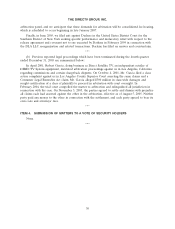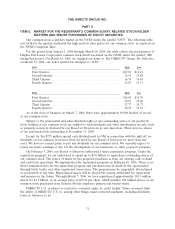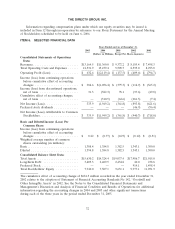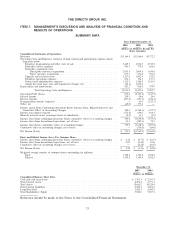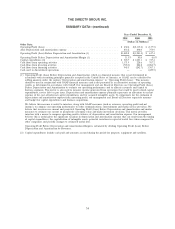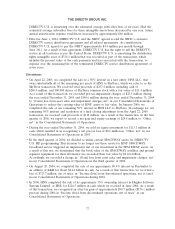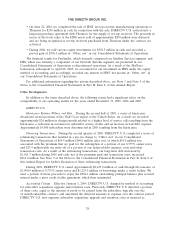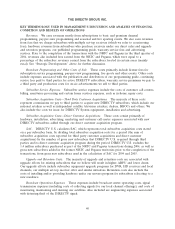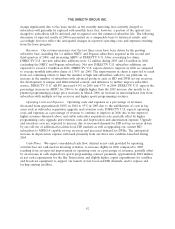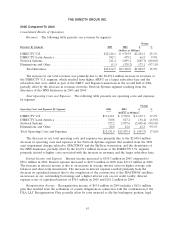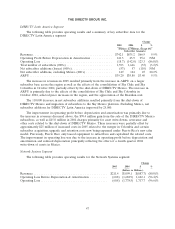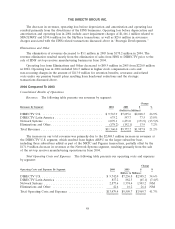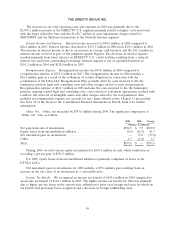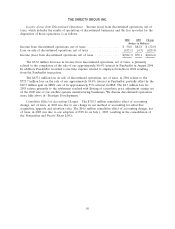DIRECTV 2005 Annual Report Download - page 53
Download and view the complete annual report
Please find page 53 of the 2005 DIRECTV annual report below. You can navigate through the pages in the report by either clicking on the pages listed below, or by using the keyword search tool below to find specific information within the annual report.THE DIRECTV GROUP, INC.
KEY TERMINOLOGY USED IN MANAGEMENT’S DISCUSSION AND ANALYSIS OF FINANCIAL
CONDITION AND RESULTS OF OPERATIONS
Revenues. We earn revenues mostly from subscriptions to basic and premium channel
programming, pay-per-view programming and seasonal and live sporting events. We also earn revenues
from fees that we charge subscribers with multiple set-top receivers (which we refer to as mirroring
fees), hardware revenues from subscribers who purchase receivers under our direct sales and upgrade
and retention programs, our published programming guide, warranty service fees and advertising
services. Prior to the completion of the transactions with the NRTC and Pegasus in the third quarter of
2004, revenues also included fees earned from the NRTC and Pegasus, which were equal to a
percentage of the subscriber revenues earned from the subscribers located in certain areas (mainly
rural). See ‘‘Strategic Developments’’ above for further discussion.
Broadcast Programming and Other Costs of Sale. These costs primarily include license fees for
subscription service programming, pay-per-view programming, live sports and other events. Other costs
include expenses associated with the publication and distribution of our programming guide, continuing
service fees paid to third parties for active DIRECTV subscribers, warranty service premiums we pay to
a third party and production costs for on-air advertisements we sell to third parties.
Subscriber Service Expenses. Subscriber service expenses include the costs of customer call centers,
billing, remittance processing and certain home services expenses, such as in-home repair costs.
Subscriber Acquisition Costs—Third Party Customer Acquisitions. The majority of these costs
represent commissions we pay to third parties to acquire new DIRECTV subscribers, which include our
national retailers as well as independent satellite television retailers, dealers, RBOCs and others. We
also include the costs we incur for DIRECTV System equipment, installation and advertising.
Subscriber Acquisition Costs—Direct Customer Acquisitions. These costs consist primarily of
hardware, installation, advertising, marketing and customer call center expenses associated with new
DIRECTV subscribers added through our direct customer acquisition program.
SAC. DIRECTV U.S. calculates SAC, which represents total subscriber acquisition costs stated
on a per subscriber basis, by dividing total subscriber acquisition costs for a period (the sum of
subscriber acquisition costs reported for third party customer acquisitions and direct customer
acquisitions) by the number of gross new subscribers that DIRECTV U.S. acquired through third
parties and its direct customer acquisition program during the period. DIRECTV U.S. excludes the
1.4 million subscribers purchased as part of the NRTC and Pegasus transactions during 2004, as well as
gross new subscribers added in the former NRTC and Pegasus territories prior to the completion of the
transactions, from gross new subscribers used in the calculation of SAC for 2004 and 2003.
Upgrade and Retention Costs. The majority of upgrade and retention costs are associated with
upgrade efforts for existing subscribers that we believe will result in higher ARPU and lower churn.
Our upgrade efforts include subscriber equipment upgrade programs for DVR, HD receivers and local
channels, our multiple set-top receiver offer and similar initiatives. Retention costs also include the
costs of installing and/or providing hardware under our movers program for subscribers relocating to a
new residence.
Broadcast Operations Expenses. These expenses include broadcast center operating costs, signal
transmission expenses (including costs of collecting signals for our local channel offerings), and costs of
monitoring, maintaining and insuring our satellites. Also included are engineering expenses associated
with deterring theft of the DIRECTV signal.
40


